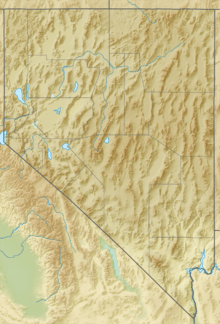Granite Range (Elko County) facts for kids
Quick facts for kids Granite Range (Elko County) |
|
|---|---|
| Highest point | |
| Elevation | 2,388 m (7,835 ft) |
| Geography | |
| Country | United States |
| State | Nevada |
| District | Elko County |
| Range coordinates | 41°43′26.691″N 114°40′23.125″W / 41.72408083°N 114.67309028°W |
| Topo map | USGS Blanchard Mountain |
The Granite Range is a mountain range located in Elko County, Nevada. It gets its name from the type of rock that makes up a big part of its mountains: granite. This range is a natural landmark in the northeastern part of Nevada.
Contents
What is a Mountain Range?
A mountain range is a group of mountains that are connected. They are usually formed by the same geological processes. The Granite Range is one of many mountain ranges that crisscross the state of Nevada. These ranges often have unique plants and animals.
Where is the Granite Range?
The Granite Range is found in Elko County, Nevada. This county is in the northeastern part of the state. The range is part of the larger Great Basin region. The Great Basin is a vast area of deserts and mountains. It covers parts of Nevada, Utah, and other nearby states.
Elevation and Size
The highest point in the Granite Range reaches about 2,388 meters (7,835 feet) above sea level. This makes it a significant feature in the local landscape. While not one of the tallest ranges in Nevada, it stands out in its area.
The Rocks of the Range
The name "Granite Range" tells us a lot about its geology. Granite is a very common type of igneous rock. Igneous rocks are formed when molten rock (magma) cools and hardens. Granite forms deep underground. It is known for its coarse grains and often light color. It can be pink, gray, or white.
How Mountains Form
Mountain ranges like the Granite Range are usually formed over millions of years. This happens through a process called plate tectonics. The Earth's outer layer is made of large plates. These plates are always slowly moving. When two plates collide, one can be forced under the other. This can push up the land above, creating mountains. Sometimes, the land cracks and shifts, forming faults. Movement along these faults can also lift up blocks of land, forming mountain ranges.
Plants and Animals
The Granite Range is home to various plants and animals. These living things have adapted to the dry, desert climate of Nevada.
Plant Life
The lower parts of the range are covered in sagebrush. Sagebrush is a tough, woody shrub. It is very common in the Great Basin. You might also find juniper trees and pinyon pines. These trees are well-suited to dry conditions. They often grow on the slopes of the mountains. Wildflowers can bloom in the spring. They add splashes of color to the landscape.
Animal Life
Many animals live in the Granite Range. They find food, water, and shelter here. Some common animals include:
- Mule deer: These deer are often seen grazing on the slopes.
- Jackrabbits: These large hares are fast runners.
- Coyotes: These clever predators hunt smaller animals.
- Birds of prey: Eagles, hawks, and owls soar above the range. They hunt rodents and other small creatures.
- Reptiles: Various lizards and snakes live among the rocks. They are well-adapted to the desert heat.
Climate of the Granite Range
The climate in the Granite Range is typical of the Great Basin. It has hot, dry summers and cold winters. Most of the precipitation (rain and snow) falls during the winter months. Snow can cover the higher peaks. The lower elevations receive very little rainfall. This dry environment shapes the types of plants and animals that can survive here.
Importance of Mountain Ranges
Mountain ranges like the Granite Range are important for many reasons:
- Water sources: They can collect snow and rain. This water then melts and flows into streams and rivers. These are vital for wildlife and human communities.
- Habitats: They provide diverse habitats for many species.
- Recreation: People enjoy hiking, camping, and exploring in mountain areas.
- Natural beauty: They offer stunning views and a sense of wilderness.
The Granite Range is a quiet but important part of Nevada's natural landscape. It reminds us of the powerful forces that shape our Earth.


